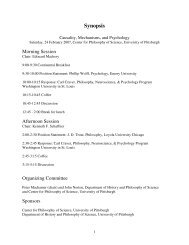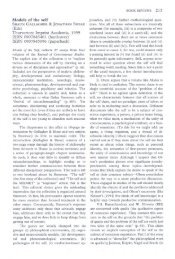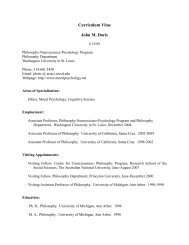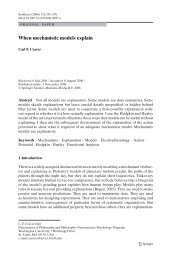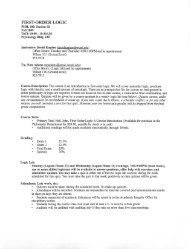The Blackwell Guide to the Philosophy of Science - The Department ...
The Blackwell Guide to the Philosophy of Science - The Department ...
The Blackwell Guide to the Philosophy of Science - The Department ...
You also want an ePaper? Increase the reach of your titles
YUMPU automatically turns print PDFs into web optimized ePapers that Google loves.
Cognitive <strong>Science</strong><br />
<strong>The</strong> cognitive revolution made common currency <strong>of</strong> <strong>the</strong> view that complex<br />
behavior is, in large part at least, controlled by inner representational states. <strong>The</strong>se<br />
representations carry contents – <strong>the</strong>y are about things – and <strong>the</strong>y are operated on<br />
by processes in such a way that <strong>the</strong> system can solve problems or make plans. <strong>The</strong>se<br />
two <strong>to</strong>pics, <strong>the</strong> nature <strong>of</strong> <strong>the</strong> processes or “cognitive architecture,” and <strong>the</strong><br />
contents carried by representational states, have attracted <strong>the</strong> bulk <strong>of</strong> <strong>the</strong> interest<br />
in <strong>the</strong> philosophy <strong>of</strong> cognitive science.<br />
Current Topics<br />
Cognitive architecture<br />
Perhaps <strong>the</strong> first philosophical issue broached by <strong>the</strong> cognitive revolution was <strong>the</strong><br />
issue <strong>of</strong> architecture. Now that inner representational states were given a new lease,<br />
<strong>the</strong> questions <strong>of</strong> what processes operated on <strong>the</strong>m and what <strong>the</strong>y were came <strong>to</strong><br />
<strong>the</strong> fore. <strong>The</strong> following two subsections briefly discuss <strong>the</strong> two primary trends on<br />
this <strong>to</strong>pic in <strong>the</strong> last three or so decades.<br />
“Classical” cognitive science and artificial intelligence <strong>The</strong> rise <strong>of</strong> computer<br />
science made available a way <strong>of</strong> thinking about <strong>the</strong> mind which has had great influence.<br />
<strong>The</strong> idea was that <strong>the</strong> mind is like a program, and <strong>the</strong> brain is <strong>the</strong> hardware<br />
(or “wetware”) on which this program runs; see, for example, Turing (1950) and<br />
Newell and Simon (1976). <strong>The</strong> computer model provides an architecture according<br />
<strong>to</strong> which <strong>the</strong> states <strong>of</strong> <strong>the</strong> cognitive system are, in <strong>the</strong> first instance, representational<br />
states with conceptual contents corresponding <strong>to</strong> entities like names,<br />
predicates, quantifiers, etc., in natural language (Fodor, 1975). Combinations <strong>of</strong><br />
<strong>the</strong>se yield representations with propositional contents. And <strong>the</strong> processes which<br />
operate over <strong>the</strong>se representations are primarily inferential, and learning conceived<br />
<strong>of</strong> as a matter <strong>of</strong> hypo<strong>the</strong>sis formulation and testing.<br />
This idea has a number <strong>of</strong> prima facie advantages. First, it renders <strong>the</strong> mind<br />
on<strong>to</strong>logically unmysterious, for <strong>the</strong> mind is merely a certain functional organization<br />
<strong>of</strong> matter. Second, it seems <strong>to</strong> secure a lasting role for psychology in <strong>the</strong> face<br />
<strong>of</strong> threats <strong>to</strong> <strong>the</strong> effect that neuroscience will tell us all we need <strong>to</strong> know about<br />
<strong>the</strong> mind, and at <strong>the</strong> same time <strong>to</strong> tell us what <strong>the</strong> correct <strong>to</strong>ols are for <strong>the</strong>orizing<br />
about <strong>the</strong> mind. This is because if <strong>the</strong> mind is like a computer program, <strong>the</strong>n<br />
<strong>the</strong> brain is more or less irrelevant <strong>to</strong> understanding it. In <strong>the</strong> same way that one<br />
can learn all about, e.g., a certain word processing program regardless <strong>of</strong> what<br />
kind <strong>of</strong> computer it happens <strong>to</strong> be running on (amount <strong>of</strong> memory, type <strong>of</strong> processor,<br />
operating system, etc.), so <strong>to</strong>o, <strong>the</strong> details <strong>of</strong> <strong>the</strong> mind are independent <strong>of</strong><br />
implementation. Studying a computer will not tell you anything about <strong>the</strong><br />
programs one might run on it. Ra<strong>the</strong>r, we study <strong>the</strong> input–output operation <strong>of</strong><br />
<strong>the</strong> mind, how it behaves when it breaks down in various ways, and on <strong>the</strong> basis<br />
<strong>of</strong> this we learn about <strong>the</strong> program that <strong>the</strong> brain is running.<br />
275



